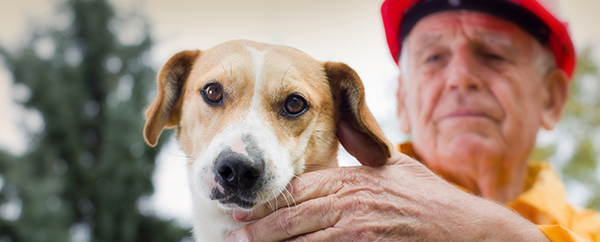When a temblor strikes, be prepared to keep pets safe during an earthquake
- Make sure your disaster plan includes pet care.
- Ensure your pets have current ID tags or chips.
- Keep pets’ medical records safe and assessable.
- Create a pet emergency kit.
- Learn more tips here.
As much as we may not like to think about a natural disaster like an earthquake that could hit at any time, it’s nevertheless a good idea to make sure you’re prepared — for yourself and your pets. Our pets depend on us to defend them and keep them safe; if we aren’t prepared, neither are they. Whether you need to evacuate or shelter in place, it is vital that you have advance plans in place to keep pets safe during an earthquake.
View our Earthquake Hub for more articles on how to prepare for and what to do during and after a quake.
We’ve put together a list of tips to follow to help keep you and your pets safe before, during and after an earthquake:
- Create a disaster plan that includes your pets. Make sure they’re secured with harnesses or in carriers to help keep them calm.
- Make sure pets are properly identified with a collar, tags, or microchip. Even when pets are inside, they should wear IDs for their safety. Be sure these are kept up to date with your current address and phone number.
- Be familiar with their preferred hiding places. Some pets, especially cats, will hide when they’re frightened. Take note of where they have hidden in the past to make finding them an easier task.
- Keep your pet’s health information current. If your pet becomes lost or stays in a shelter with other animals, he may be exposed to infectious diseases. You may also consider consulting your veterinarian after your pet comes home.
- Display a pet alert sign on your home or property. Window stickers are available that let first responders know there are animals inside your home.
- Keep a medical record and current photo of your pet. Share this information with animal shelters or other agencies that might find your pet, should you get separated.
- Build a natural disaster emergency kit. Include vaccination and veterinary records, food, bottled water, and any pet medications, as well as one or two or their favorite toys to help keep them calm and occupied. The Humane Society offers guidance on what to include in a pet disaster preparedness kit.
- Continue to monitor. In any significant earthquake, aftershocks are almost inevitable. Be ready to help frightened pets through those, too.
- Check animal shelters. If your pet becomes lost, make the local animal shelter your first place to look.
Related: Why your West Coast homeowners need Arrowhead’s Residential Earthquake Insurance
What to include in a pet emergency kit
PC 360 suggests the following items to include in your pet’s emergency kit:
- Your kit should include your contact information, along with that of a friend or relative who knows the pet.
- Keep your pet’s microchip number in a safe place where you can access it, if your pet gets separated from you.
- Include in your kit a copy of the pet’s medical records including vaccinations, prescription medicines and medical history.
- Add at least two weeks of your pet’s prescription medicines.
- Also add two weeks of food and water, along with bedding, a favorite blanket or toys.
- Pack plastic “poop bags” for your dog and a litter box with extra litter for your cat. Consider adding cleaning supplies in case of an accident.
- Each pet should have its own carrier, properly labeled with the pet’s name, your name and contact information.
Unlike hurricanes and other natural disasters, it’s difficult to predict earthquakes. So follow these preparation tips and keep pets safe during an earthquake.
Related: How to minimize earthquake damage and injury
Sources:
https://www.petcoach.co/article/how-to-keep-your-pets-safe-during-a-natural-disaster/
https://www.latimes.com/home/la-hm-earthquake-preparedness-for-your-pets-20190713-story.html
https://blog.healthypawspetinsurance.com/how-to-keep-pets-safe-before-during-and-after-an-earthquake

